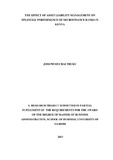| dc.description.abstract | Asset liability management is an approach that provides institutions with protection
that makes such risk acceptable. Asset-liability management models enable
institutions to measure and monitor risk, and provide suitable strategies for their
management. Following the financial liberation of the finance sector in Kenya, there
has been a tremendous growth of commercial banks that have intensified competition
in the banking industry. This has triggered the need for risk management among
banks to minimize risks of financial loss and thus boost financial performance. To
achieve the objective of this study the researcher used a descriptive research design to
establish the relationship between asset liability management and profitability of
microfinance banks in Kenya. The study carried out a census survey of nine (9)
microfinance banks that had been in operation for five years (2010-2014). The study
used secondary sources of data since the nature of data to be collected is quantitative.
Secondary data was obtained from the association of microfinance banks in Kenya
(AMFI) based on availability and accessibility. The data was extracted from audited
financial statements of microfinance banks for the period of five years (2010-2014).
Data selection was done based on the measurements of the variables under
investigation. Data analysis was done using decretive statistics, correlation analysis
and regression analysis. The findings concluded that most microfinance banks were
not able maintain optimal levels of assets and liability and thus were unable to meet
their short-term financial obligations. The findings also revealed that asset quality
increased rapidly over the years. Microfinance banks gave out huge loans and
advances that contributed to increased non-performing loans, this impacted negatively
on asset and liability management leading to poor financial performance of
microfinance banks. The correlation results concluded that there was no correlation
between asset quality, liquidity and firm size with financial performance of
microfinance banks in Kenya apart from operating efficiency which was strongly
correlated to financial performance of microfinance banks in Kenya. The regression
results concluded that asset and liability management was negatively related to
profitability of microfinance banks in Kenya. Logarithm of assets and operating
efficiency were found to be statistically significant in the model. On the contrary,
asset quality and liquidity were found to be statistically insignificant because their
probability values were above 5%. The limitation for this study is that it utilized
secondary sources of data that are prepared under accounting and financial reporting
assumptions and concepts which are subjective and might not be uniformly applied
especially in terms of provisions and estimates. The study further recommends that
the role of Asset liability committees has grown in its importance in the management
of balance sheet, liquidity risks and in the implementation of liquidity risk
management strategies. Hence, there is need for further research on the role of
this important committee with a view to coming up with recommendation to
strengthen the committees role in banking institutions. | en_US |

